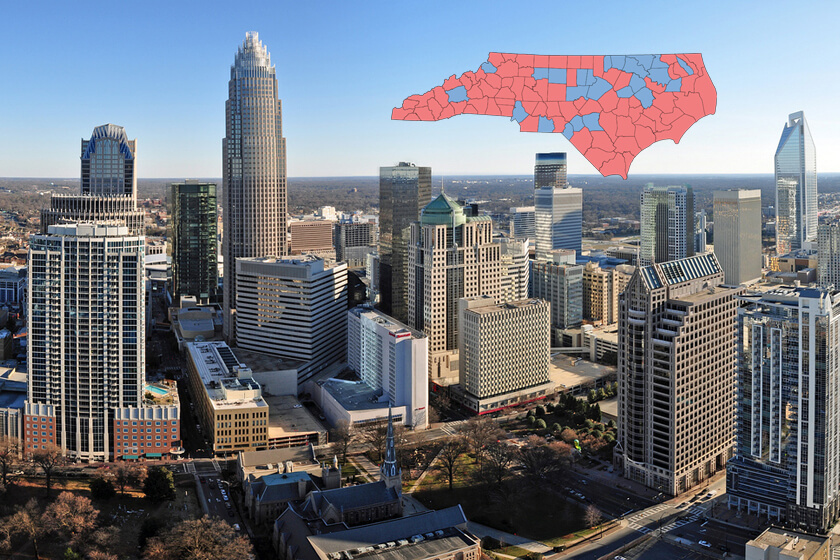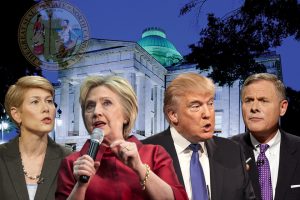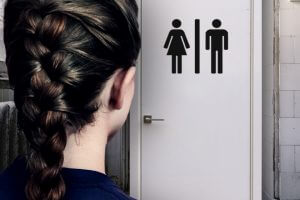West Long Branch, NJ – Joe Biden and Donald Trump are separated by a negligible 2-point margin among all registered voters in North Carolina according to the Monmouth (“Mon-muth”) University Poll, while the U.S. Senate race is even tighter. Gov. Roy Cooper, on the other hand, currently enjoys a large lead in his reelection bid on the back of strong voter approval of his handling of the Covid-19 crisis.
Among all registered voters in North Carolina, the race for president stands at 47% for Biden and 45% for Trump. Another 3% support Jo Jorgensen (Libertarian), less than 1% back either Howie Hawkins (Green) or Don Blankenship (Constitution), and 3% are undecided. Voter intent includes 41% who say they are certain to vote for Biden (versus 44% who say they are not at all likely to support the Democrat) and 40% who are certain to support Trump (versus 47% who are not at all likely).
Under a likely voter scenario with a somewhat higher level of turnout than 2016, Biden stands at 48% support and Trump is at 46%. The results are an identical 48% to 46% when using a likely voter model with lower turnout. Each of the last three presidential elections were decided by fewer than four percentage points in North Carolina.
The two candidates earn similar personal ratings. Biden has a 43% favorable to 48% unfavorable rating among registered voters, including 35% very unfavorable. By comparison, 46% of North Carolina voters have a favorable opinion of Trump and 46% have an unfavorable one, including 40% very unfavorable.
“North Carolina has been in play for each of the last three presidential elections and it is going to be that way again this year, especially with a pivotal Senate race sharing the ballot,” said Patrick Murray, director of the independent Monmouth University Polling Institute.
Trump has solid support among white voters without a college degree (66% to 28%), while Biden has a narrow edge among white college graduates (48% to 42%). The Democrat has a large advantage among voters of color (78% to 15% – including an 85% to 10% lead among Black voters in this group).
The race is especially tight in 22 counties where the vote margins were closest in the 2016 presidential election. The Democrat currently holds an insignificant 48% to 46% edge among registered voters in these swing counties* where the aggregate vote went to Hillary Clinton by a single point. The poll finds that Biden racks up a 58% to 33% margin in counties that went solidly for Clinton (by a similar 27 points in 2016). Trump leads in the counties he won handily four years ago (54% to 37%), but this lead is not quite as large as his 34-point aggregate victory there four years ago.
“An interesting thing about North Carolina is that fewer voters live in swing counties compared with other purple states. One reason Democrats are competitive here is that the core blue areas are strung in a chain across the state rather than clumped in one or two geographic areas,” said Murray.
| NORTH CAROLINA: VOTER MODELS | ||||
| Office: | Registered voters | High likely turnout | Low likely turnout | |
| President | ||||
| Biden (D) | 47% | 48% | 48% | |
| Trump (R) | 45% | 46% | 46% | |
| Other | 5% | 3% | 3% | |
| Undecided | 3% | 3% | 3% | |
| U.S. Senator | ||||
| Cunningham (D) | 46% | 47% | 46% | |
| Tillis (R) | 45% | 45% | 46% | |
| Other | 3% | 4% | 4% | |
| Undecided | 5% | 4% | 4% | |
| Governor | ||||
| Cooper (D) | 51% | 51% | 51% | |
| Forest (R) | 40% | 42% | 42% | |
| Other | 4% | 5% | 5% | |
| Undecided | 3% | 2% | 2% | |
| Source: Monmouth University Poll, Aug. 29-Sep. 1, 2020 | ||||
– Other contests –
The Monmouth University Poll finds a tight contest in the state’s U.S. Senate election. Among registered voters, Republican first-term incumbent Thom Tillis has 45% support and his Democratic challenger Cal Cunningham, an attorney and former state legislator, has 46% support. Other voter support goes to Libertarian Shannon Bray (2%) and Kevin Hayes of the Constitution Party (1%), with 5% undecided. There is a very small amount of crossover support for both candidates from the top of the ticket. Trump voters back Tillis by 88% to 6% and Biden voters back Cunningham by 87% to 6%. Cunningham performs slightly weaker among voters of color (70% to 20% for Tillis) than the Democratic candidates in the other two races Monmouth polled. Tillis leads among white voters by 54% to 37%.
Among likely voters in a high turnout scenario, Cunningham has 47% support and Tillis has 45% support. The race is even (46% to 46%) in a low turnout scenario. Tillis won the seat in 2014 by just under two percentage points against then-incumbent Kay Hagan.
In the race for governor, Democratic incumbent Cooper holds a large 51% to 40% lead over his Republican challenger, current Lieutenant Governor Dan Forest. Other voter support goes to Libertarian Steven DeFiore (3%) and Al Pisano of the Constitution Party (1%), with 3% undecided. Cooper gets some crossover support from Trump voters (14% to 80% for Forest) while locking in nearly all Biden voters (93% to 3%). Forest leads Cooper by 53% to 40% among white voters, but Cooper has a commanding 81% to 9% advantage among voters of color.
The incumbent maintains a sizable lead among likely voters by 51% to 42% in both the high turnout and low turnout models. In 2016, Cooper beat then-incumbent Pat McCrory by a razor thin margin of just over 10,000 votes.
The poll finds Gov. Cooper has the best overall image among the candidates included in the poll. Currently, 50% of North Carolina voters have a favorable opinion of him and 31% have an unfavorable one, with 19% having no opinion. His opponent, Forest, earns a 32% favorable and 26% unfavorable rating, with 43% having no opinion. Sen. Tillis gets a split 35% favorable and 35% unfavorable rating, with 31% having no opinion. His challenger, Cunningham, gets a 34% favorable and 22% unfavorable rating, with 44% having no opinion.
– Other issues –
Speakers at the Republican National Convention made a direct appeal to voters who may be concerned that their suburban communities are being threatened. When asked about different people moving into nice neighborhoods who may bring crime and lower property values, 13% of North Carolina voters say this is a major problem and 29% say it is a minor problem, while 50% say it is not a problem. Republicans (58%) are most likely to say this is at least a minor problem, but they are joined in this view by 4 in 10 independents (40%) and 3 in 10 Democrats (29%). About 1 in 4 voters (24%) say they are concerned about this type of thing happening in their own community, including 35% of Republicans, 23% of Democrats, and 14% of independents.
On the larger issue of race relations, more North Carolina voters say they have confidence in Biden’s ability to handle this issue (50% great deal/some and 47% not much/none at all) than say the same about Trump (42% great deal/some and 56% not much/none at all).
Another weak spot for the incumbent president is his handling of the coronavirus outbreak. Currently, 46% of registered voters say he has done a good job while 51% say he has done a bad job. By contrast, Gov. Cooper earns praise on this issue – 65% say he has done a good job and 31% say he has done a bad job.
“Cooper’s handling of the pandemic is one reason why he is in much better position than Democrats running at the top of the ticket,” said Murray.
Just under half (44%) of North Carolina voters say the measures taken by their state government to slow the spread of the virus have been appropriate. Another 27% say they have gone too far and 26% say they have not gone far enough. More than a third (36%) of Republicans join 52% of Democrats and 44% of independents in deeming their state’s actions as appropriate. More voters are concerned that North Carolina is lifting restrictions too quickly (43%) than express concern that restrictions are not being lifted quickly enough (38%).
In terms of voting this year, Republicans (53%) are more likely than Democrats (24%) and independents (22%) to say they are very optimistic about the 2020 presidential election. They are also more likely to feel more enthusiastic about this year’s contest compared to past elections – 53% of Republicans versus 44% of Democrats and 33% of independents say this.
Over 1 in 4 (27%) North Carolina voters report they are at least somewhat likely to cast their vote by mail this year. This result is lower than in a national Monmouth poll in August, which showed about half (49%) the American electorate inclined to vote by mail. All voters in the state may request an absentee ballot, although North Carolina also has a two-week early voting period for people who want to avoid the crowds on Election Day. Democrats in the Tar Heel State (41%) are more likely than independents (27%) and Republicans (13%) to say they will vote by mail. There is less of a partisan divide on confidence that the November election will be conducted fairly and accurately. This sentiment registers at 56% very or somewhat confident among all registered voters, 66% among Democrats, 56% among Republicans, and 48% among independents.
The Monmouth University Poll was conducted by telephone from August 29 to September 1, 2020 with 401 North Carolina registered voters. The question results in this release have a margin of error of +/- 4.9 percentage points. The poll was conducted by the Monmouth University Polling Institute in West Long Branch, NJ.
* 2016 presidential margin by county groupings:
Swing (18% of turnout) – 22 counties where the winning margin for either candidate was less than 12 points, with a cumulative vote of 48.7% Clinton and 47.6% Trump.
Clinton (40% of turnout) – Clinton won these 16 counties by 12 points or more, with a cumulative vote of 61.1% to 34.3%, with Wake and Mecklenburg making up the lion’s share.
Trump (42% of turnout) – Trump won these 62 counties by 12 points or more, with a cumulative vote of 65.3% to 31.1%.
QUESTIONS AND RESULTS
(* Some columns may not add to 100% due to rounding.)
1. If the election for President was today, would you vote for … Donald Trump the Republican, Joe Biden the Democrat, Jo Jorgensen the Libertarian, Howie Hawkins of the Green Party, or Don Blankenship of the Constitution Party? [NAMES WERE ROTATED] [If UNDECIDED: If you had to vote for one of the following candidates at this moment, who do you lean toward – Donald Trump or Joe Biden?]
| REGISTERED VOTERS (with leaners) | Aug. 2020 |
| Donald Trump | 45% |
| Joe Biden | 47% |
| Jo Jorgensen | 3% |
| Howie Hawkins | <1% |
| Don Blankenship | <1% |
| (VOL) Other candidate | 1% |
| (VOL) No one | 1% |
| (VOL) Undecided | 3% |
| (n) | (401) |
[1A. If Trump/Biden voter, ASK: Are you certain about your vote choice, or might you change your mind before election day?]
[QUESTIONS 2 & 3 WERE ROTATED]
2. What is the likelihood that you might vote for Donald Trump in November – very likely, somewhat likely, not too likely, or not at all likely?
| REGISTERED VOTERS | Aug. 2020 |
| Certain for Trump (from Q1/A) | 40% |
| Very likely | 2% |
| Somewhat likely | 6% |
| Not too likely | 4% |
| Not at all likely | 47% |
| (VOL) Don’t know | 2% |
| (n) | (401) |
3. What is the likelihood that you might vote for Joe Biden in November – very likely, somewhat likely, not too likely, or not at all likely?
| REGISTERED VOTERS | Aug. 2020 |
| Certain for Biden (from Q1/A) | 41% |
| Very likely | 2% |
| Somewhat likely | 6% |
| Not too likely | 3% |
| Not at all likely | 44% |
| (VOL) Don’t know | 3% |
| (n) | (401) |
4. If the election for U.S. Senate was today, would you vote for … Thom Tillis the Republican, Cal Cunningham the Democrat, Shannon Bray the Libertarian, or Kevin Hayes of the Constitution Party? [NAMES WERE ROTATED] [If UNDECIDED: If you had to vote for one of the following candidates at this moment, who do you lean toward – Thom Tillis or Cal Cunningham?]
| REGISTERED VOTERS (with leaners) | Aug. 2020 |
| Thom Tillis | 45% |
| Cal Cunningham | 46% |
| Shannon Bray | 2% |
| Kevin Hayes | 1% |
| (VOL) Other candidate | <1% |
| (VOL) No one | 1% |
| (VOL) Undecided | 5% |
| (n) | (401) |
5. If the election for Governor was today, would you vote for … Dan Forest the Republican, Roy Cooper the Democrat, Steven DiFiore the Libertarian, or Al Pisano of the Constitution Party? [NAMES WERE ROTATED] [If UNDECIDED: If you had to vote for one of the following candidates at this moment, who do you lean toward – Dan Forest or Roy Cooper?]
| REGISTERED VOTERS (with leaners) | Aug. 2020 |
| Dan Forest | 40% |
| Roy Cooper | 51% |
| Steven DiFiore | 3% |
| Al Pisano | 1% |
| (VOL) Other candidate | <1% |
| (VOL) No one | 1% |
| (VOL) Undecided | 3% |
| (n) | (401) |
[QUESTIONS 6 & 7 WERE ROTATED]
6. Is your general impression of Donald Trump very favorable, somewhat favorable, somewhat unfavorable, or very unfavorable, or do you have no opinion?
| REGISTERED VOTERS | Aug. 2020 |
| Very favorable | 31% |
| Somewhat favorable | 15% |
| Somewhat unfavorable | 6% |
| Very unfavorable | 40% |
| No opinion | 8% |
| (n) | (401) |
7. Is your general impression of Joe Biden very favorable, somewhat favorable, somewhat unfavorable, or very unfavorable, or do you have no opinion?
| REGISTERED VOTERS | Aug. 2020 |
| Very favorable | 24% |
| Somewhat favorable | 19% |
| Somewhat unfavorable | 13% |
| Very unfavorable | 35% |
| No opinion | 9% |
| (n) | (401) |
8. Please tell me if your general impression of each of the following people is favorable or unfavorable, or if you don’t really have an opinion. [NAMES WERE ROTATED]
Thom Tillis
| REGISTERED VOTERS | Aug. 2020 |
| Favorable | 35% |
| Unfavorable | 35% |
| No opinion | 31% |
| (n) | (401) |
Cal Cunningham
| REGISTERED VOTERS | Aug. 2020 |
| Favorable | 34% |
| Unfavorable | 22% |
| No opinion | 44% |
| (n) | (401) |
Dan Forest
| REGISTERED VOTERS | Aug. 2020 |
| Favorable | 32% |
| Unfavorable | 26% |
| No opinion | 43% |
| (n) | (401) |
Roy Cooper
| REGISTERED VOTERS | Aug. 2020 |
| Favorable | 50% |
| Unfavorable | 31% |
| No opinion | 19% |
| (n) | (401) |
9. Do you feel optimistic or pessimistic about the 2020 presidential election? [Is that very or somewhat optimistic/pessimistic]?
| REGISTERED VOTERS | Aug. 2020 |
| Very optimistic | 31% |
| Somewhat optimistic | 39% |
| Somewhat pessimistic | 13% |
| Very pessimistic | 9% |
| (VOL) Neither, don’t care | 5% |
| (VOL) Don’t know | 3% |
| (n) | (401) |
10. How motivated are you to vote in the November election for president – very motivated, somewhat motivated, or not that motivated?
| REGISTERED VOTERS | Aug. 2020 |
| Very motivated | 84% |
| Somewhat motivated | 12% |
| Not that motivated | 4% |
| (VOL) Don’t know | 0% |
| (n) | (401) |
11. Compared to past elections, are you more enthusiastic than usual, less enthusiastic, or about the same as past elections?
| REGISTERED VOTERS | Aug. 2020 |
| More enthusiastic | 42% |
| Less enthusiastic | 13% |
| About the same | 44% |
| (VOL) Don’t know | 1% |
| (n) | (401) |
12. How likely are you to cast your vote by mail in the November election rather than in person – very likely, somewhat likely, not too likely, or not at all likely?
| REGISTERED VOTERS | Aug. 2020 |
| Very likely | 16% |
| Somewhat likely | 11% |
| Not too likely | 12% |
| Not at all likely | 59% |
| (VOL) Won’t vote at all | 0% |
| (VOL) Don’t know | 2% |
| (n) | (401) |
13. Overall, how confident are you that the November election will be conducted fairly and accurately – very confident, somewhat confident, not too confident, or not at all confident?
| REGISTERED VOTERS | Aug. 2020 |
| Very confident | 14% |
| Somewhat confident | 42% |
| Not too confident | 22% |
| Not at all confident | 19% |
| (VOL) Don’t know | 4% |
| (n) | (401) |
14. How much of a problem do suburban communities face today because of different people moving into nice neighborhoods who may bring in crime and lower property values? Is this a major problem, a minor problem, or not a problem?
| REGISTERED VOTERS | Aug. 2020 |
| Major problem | 13% |
| Minor problem | 29% |
| Not a problem | 50% |
| (VOL) Depends | 1% |
| (VOL) Don’t know | 6% |
| (n) | (401) |
15. How concerned are you about this happening in your own community – very concerned, somewhat concerned, not too concerned, or not at all concerned?
| REGISTERED VOTERS | Aug. 2020 |
| Very concerned | 10% |
| Somewhat concerned | 14% |
| Not too concerned | 21% |
| Not at all concerned | 54% |
| (VOL) Don’t know | 1% |
| (n) | (401) |
[QUESTIONS 16 & 17 WERE ROTATED]
16. How much confidence do you have in Donald Trump’s ability to handle race relations – a great deal, some, not much, or none at all?
| REGISTERED VOTERS | Aug. 2020 |
| Great deal | 27% |
| Some | 15% |
| Not much | 10% |
| None at all | 46% |
| (VOL) Don’t know | 2% |
| (n) | (401) |
17. How much confidence do you have in Joe Biden’s ability to handle race relations – a great deal, some, not much, or none at all?
| REGISTERED VOTERS | Aug. 2020 |
| Great deal | 24% |
| Some | 26% |
| Not much | 12% |
| None at all | 35% |
| (VOL) Don’t know | 2% |
| (n) | (401) |
[QUESTIONS 18 & 19 WERE ROTATED]
18. Has Donald Trump done a good job or bad job handling the coronavirus outbreak? [Is that very or somewhat good/bad?]
| REGISTERED VOTERS | Aug. 2020 |
| Very good | 27% |
| Somewhat good | 19% |
| Somewhat bad | 8% |
| Very bad | 43% |
| (VOL) Don’t know | 3% |
| (n) | (401) |
19. Has Governor Roy Cooper done a good job or bad job handling the coronavirus outbreak? [Is that very or somewhat good/bad?]
| REGISTERED VOTERS | Aug. 2020 |
| Very good | 33% |
| Somewhat good | 32% |
| Somewhat bad | 11% |
| Very bad | 20% |
| (VOL) Don’t know | 4% |
| (n) | (401) |
20. Have the measures taken by your state government to slow the spread of the virus been appropriate, have they gone too far, or have they not gone far enough?
| REGISTERED VOTERS | Aug. 2020 |
| Appropriate | 44% |
| Gone too far | 27% |
| Not gone far enough | 26% |
| (VOL) Don’t know | 3% |
| (n) | (401) |
21. Are you more concerned that North Carolina is lifting restrictions too quickly or not quickly enough?
| REGISTERED VOTERS | Aug. 2020 |
| Too quickly | 43% |
| Not quickly enough | 38% |
| (VOL) Not concerned either way | 13% |
| (VOL) Don’t know | 6% |
| (n) | (401) |
METHODOLOGY
The Monmouth University Poll was sponsored and conducted by the Monmouth University Polling Institute from August 29 to September 1, 2020 with a statewide random sample of 401 North Carolina voters drawn from a list of registered voters. This includes 110 contacted by a live interviewer on a landline telephone and 291 contacted by a live interviewer on a cell phone, in English. Monmouth is responsible for all aspects of the survey design, data weighting and analysis. The full sample is weighted for party registration, age, gender, race, education, and region based on state voter registration list information and U.S. Census information (CPS 2018 supplement). Data collection support provided by Braun Research (field) and Aristotle (voter sample). For results based on the full voter sample, one can say with 95% confidence that the error attributable to sampling has a maximum margin of plus or minus 4.9 percentage points (unadjusted for sample design). Sampling error can be larger for sub-groups (see table below). In addition to sampling error, one should bear in mind that question wording and practical difficulties in conducting surveys can introduce error or bias into the findings of opinion polls.
| DEMOGRAPHICS (weighted) |
| REGISTERED VOTERS |
| Party Registration |
| 30% Republican |
| 34% Other/none |
| 36% Democrat |
| Self-Reported Party |
| 28% Republican |
| 38% Independent |
| 34% Democrat |
| 46% Male |
| 54% Female |
| 24% 18-34 |
| 23% 35-49 |
| 27% 50-64 |
| 26% 65+ |
| 71% White, non-Hispanic |
| 22% Black |
| 4% Hispanic |
| 2% Asian |
| 1% Other race |
| 66% No degree |
| 34% 4 year degree |
Click on pdf file link below for full methodology and crosstabs by key demographic groups.




